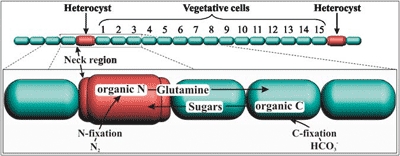Home > Press > Piecing together the Cyanobacteria puzzle
 |
| Model of C- and N fixation and transport in a filament of A. oscillarioides showing two heterocysts. The numbers indicate vegetative cells at different distances from the heterocysts. |
Abstract:
Blue green algae are significant species in the global carbon cycle because they transform nitrogen gas from the atmosphere into a useable nutrient, enabling photosynthesis in nutrient-poor waters.
Piecing together the Cyanobacteria puzzle
LIVERMORE, CA | Posted on July 10th, 2007Using NanoSIMS (high- resolution secondary ion mass spectrometer), Lawrence Livermore National Laboratory, USC and Portland State University scientists showed that they could image and track nutrient uptake in blue green algae at the nanoscale. The new method should help to clear up the age-old puzzle of how different species of blue green algae can "fix" or take up atmospheric nitrogen and carbon in a single cell organism. Carbon fixation during photosynthesis produces oxygen, which inhibits nitrogen fixation.
Different species of blue green algae solve the problem in different ways and scientists still don‚t understand how some of the most important species can get both of these jobs done.
To develop the new method, the researchers studied the freshwater algae, Anabaena oscillarioides, which separates the two processes into adjacent cells that share the products. LLNL researchers Peter Weber, Jennifer Pett-Ridge, Stewart Fallon and Ian Hutcheon used NanoSIMS to track the uptake and movement of carbon and nitrogen inside two types of cells in the algae: vegetative cells, which perform carbon fixation, and heterocysts, thick-walled relatives that pull in nitrogen.
NanoSIMS provides the ability to map distributions of elements and isotopes with 50-100-nanometer resolution. The device allowed the scientists to measure the carbon and nitrogen uptake and subsequent distribution at the cellular and subcellular level.
"The method shows the dynamics of resource uptake and redistribution down to the level of sub-micron nitrogen storage and cell wall formation during cell division," Weber said.
The researchers used stable isotope tracers in nitrogen and carbon dioxide gases to track nitrogen and carbon fixation. After a few hours of incubation, vegetative cells exhibited a large enrichment in carbon and nitrogen isotopes because of active carbon and nitrogen uptake and intercellular exchange. During photosynthesis, most of the newly fixed carbon was allocated to vegetative cells because they are rapidly dividing, while heterocysts require very little carbon because they are non-growing cells.
The NanoSIMS images showed that mature heterocysts are distinguishable from the vegetative cells based on their size, shape and intercellular distance.
The method also showed that newly fixed nitrogen levels are higher in vegetative cells than in mature heterocysts.
"We were able to see on a cell by cell basis how newly fixed nitrogen is rapidly exported from the heterocysts to vegetative cells, keeping pace with the nitrogen demands of the growing and dividing vegetative cells," Weber said. "Now we can take these results and apply them to poorly understood species."
USC's Kenneth Nealson predicts that NanoSIMS opens up a whole new field of study.
"You can use this technology to look at things going on inside the cell," he said. "This is going to change the way that we do a lot of microbiology."
The research appears in the latest issue of The International Society for Microbial Ecology (ISME) Journal.
####
About Lawrence Livermore National Laboratory
Founded in 1952, Lawrence Livermore National Laboratory has a mission to ensure national security and to apply science and technology to the important issues of our time. Lawrence Livermore National Laboratory is managed by the University of California for the U.S. Department of Energy‚s National Nuclear Security Administration. Laboratory news releases and photos are also available at http://www.llnl.gov/PAO and on UC Newswi
For more information, please click here
Contacts:
Anne M.Stark
(925) 422-9799
Copyright © Lawrence Livermore National Laboratory
If you have a comment, please Contact us.Issuers of news releases, not 7th Wave, Inc. or Nanotechnology Now, are solely responsible for the accuracy of the content.
| Related News Press |
Discoveries
![]() Chemical reactions can scramble quantum information as well as black holes April 5th, 2024
Chemical reactions can scramble quantum information as well as black holes April 5th, 2024
![]() New micromaterial releases nanoparticles that selectively destroy cancer cells April 5th, 2024
New micromaterial releases nanoparticles that selectively destroy cancer cells April 5th, 2024
![]() Utilizing palladium for addressing contact issues of buried oxide thin film transistors April 5th, 2024
Utilizing palladium for addressing contact issues of buried oxide thin film transistors April 5th, 2024
Announcements
![]() NRL charters Navy’s quantum inertial navigation path to reduce drift April 5th, 2024
NRL charters Navy’s quantum inertial navigation path to reduce drift April 5th, 2024
![]() Discovery points path to flash-like memory for storing qubits: Rice find could hasten development of nonvolatile quantum memory April 5th, 2024
Discovery points path to flash-like memory for storing qubits: Rice find could hasten development of nonvolatile quantum memory April 5th, 2024
Tools
![]() Ferroelectrically modulate the Fermi level of graphene oxide to enhance SERS response November 3rd, 2023
Ferroelectrically modulate the Fermi level of graphene oxide to enhance SERS response November 3rd, 2023
![]() The USTC realizes In situ electron paramagnetic resonance spectroscopy using single nanodiamond sensors November 3rd, 2023
The USTC realizes In situ electron paramagnetic resonance spectroscopy using single nanodiamond sensors November 3rd, 2023
|
|
||
|
|
||
| The latest news from around the world, FREE | ||
|
|
||
|
|
||
| Premium Products | ||
|
|
||
|
Only the news you want to read!
Learn More |
||
|
|
||
|
Full-service, expert consulting
Learn More |
||
|
|
||








